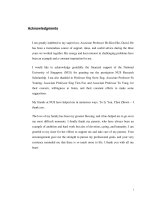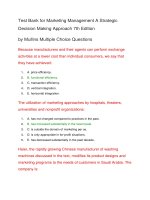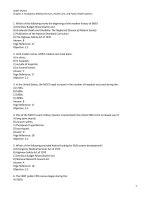Business statistics a decision making approach 6th edition ch15ppln
Bạn đang xem bản rút gọn của tài liệu. Xem và tải ngay bản đầy đủ của tài liệu tại đây (1.89 MB, 60 trang )
Business Statistics:
A Decision-Making Approach
6th Edition
Chapter 15
Analyzing and Forecasting
Time-Series Data
Business Statistics: A Decision-Making Approach, 6e © 2010 PrenticeHall, Inc.
Chap 15-1
Chapter Goals
After completing this chapter, you should
be able to:
Develop and implement basic forecasting models
Identify the components present in a time series
Compute and interpret basic index numbers
Use smoothing-based forecasting models, including single
and double exponential smoothing
Apply trend-based forecasting models, including linear trend,
nonlinear trend, and seasonally adjusted trend
Business Statistics: A Decision-Making Approach, 6e © 2010 PrenticeHall, Inc.
Chap 15-2
The Importance of Forecasting
Governments forecast unemployment, interest
rates, and expected revenues from income taxes
for policy purposes
Marketing executives forecast demand, sales, and
consumer preferences for strategic planning
College administrators forecast enrollments to plan
for facilities and for faculty recruitment
Retail stores forecast demand to control inventory
levels, hire employees and provide training
Business Statistics: A Decision-Making Approach, 6e © 2010 PrenticeHall, Inc.
Chap 15-3
Time-Series Data
Numerical data obtained at regular time
intervals
The time intervals can be annually,
quarterly, daily, hourly, etc.
Example:
Year:
1999 2000 2001 2002 2003
Sales: 75.3
74.2 78.5 79.7 80.2
Business Statistics: A Decision-Making Approach, 6e © 2010 PrenticeHall, Inc.
Chap 15-4
Time Series Plot
A time-series plot is a two-dimensional
plot of time series data
the vertical axis
measures the variable
of interest
the horizontal axis
corresponds to the
time periods
Business Statistics: A Decision-Making Approach, 6e © 2010 PrenticeHall, Inc.
Chap 15-5
Time-Series Components
Time-Series
Trend
Component
Seasonal
Component
Business Statistics: A Decision-Making Approach, 6e © 2010 PrenticeHall, Inc.
Cyclical
Component
Random
Component
Chap 15-6
Trend Component
Long-run increase or decrease over
time (overall upward or downward movement)
Data taken over a long period of time
Sales
Business Statistics: A Decision-Making Approach, 6e © 2010 PrenticeHall, Inc.
nd
e
r
t
d
r
Upwa
Time
Chap 15-7
Trend Component
(continued)
Trend can be upward or downward
Trend can be linear or non-linear
Sales
Sales
Time
Downward linear trend
Business Statistics: A Decision-Making Approach, 6e © 2010 PrenticeHall, Inc.
Time
Upward nonlinear trend
Chap 15-8
Seasonal Component
Short-term regular wave-like patterns
Observed within 1 year
Often monthly or quarterly
Sales
Summer
Winter
Spring
Fall
Time (Quarterly)
Business Statistics: A Decision-Making Approach, 6e © 2010 PrenticeHall, Inc.
Chap 15-9
Cyclical Component
Long-term wave-like patterns
Regularly occur but may vary in length
Often measured peak to peak or trough to
trough
1 Cycle
Sales
Business Statistics: A Decision-Making Approach, 6e © 2010 PrenticeHall, Inc.
Year
Chap 15-10
Random Component
Unpredictable, random, “residual”
fluctuations
Due to random variations of
Nature
Accidents or unusual events
“Noise” in the time series
Business Statistics: A Decision-Making Approach, 6e © 2010 PrenticeHall, Inc.
Chap 15-11
Index Numbers
Index numbers allow relative comparisons
over time
Index numbers are reported relative to a
Base Period Index
Base period index = 100 by definition
Used for an individual item or
measurement
Business Statistics: A Decision-Making Approach, 6e © 2010 PrenticeHall, Inc.
Chap 15-12
Index Numbers
(continued)
Simple Index number formula:
yt
It = 100
y0
where
It = index number at time period t
yt = value of the time series at time t
y0 = value of the time series in the base period
Business Statistics: A Decision-Making Approach, 6e © 2010 PrenticeHall, Inc.
Chap 15-13
Index Numbers: Example
Company orders from 1995 to 2003:
Index
Year
Number of
Orders
(base year
= 2000)
1995
272
85.0
1996
288
90.0
1997
295
92.2
1998
311
97.2
1999
322
100.6
2000
320
100.0
2001
348
108.8
2002
366
114.4
2003
384
120.0
I1996
y1996
288
=
100 =
(100 ) = 90
y 2000
320
Base Year:
y 2000
320
I2000 =
100 =
(100 ) = 100
y 2000
320
I2003
Business Statistics: A Decision-Making Approach, 6e © 2010 PrenticeHall, Inc.
y 2003
384
=
100 =
(100 ) = 120
y 2000
320
Chap 15-14
Index Numbers:
Interpretation
I1996
y1996
288
=
100 =
(100 ) = 90
y 2000
320
I2000
y 2000
320
=
100 =
(100 ) = 100
y 2000
320
I2003
y 2003
384
=
100 =
(100 ) = 120
y 2000
320
Business Statistics: A Decision-Making Approach, 6e © 2010 PrenticeHall, Inc.
Orders in 1996 were 90%
of base year orders
Orders in 2000 were 100%
of base year orders (by
definition, since 2000 is the
base year)
Orders in 2003 were 120%
of base year orders
Chap 15-15
Aggregate Price Indexes
An aggregate index is used to measure the rate
of change from a base period for a group of items
Aggregate
Price Indexes
Unweighted
aggregate
price index
Weighted
aggregate
price indexes
Paasche Index
Business Statistics: A Decision-Making Approach, 6e © 2010 PrenticeHall, Inc.
Laspeyres Index
Chap 15-16
Unweighted Aggregate Price
Index
Unweighted aggregate price index
formula:
It
p
∑
=
∑p
t
(100 )
0
where
It = unweighted aggregate price index at time t
Σpt = sum of the prices for the group of items at time t
Σp0 = sum of the prices for the group of items in the base period
Business Statistics: A Decision-Making Approach, 6e © 2010 PrenticeHall, Inc.
Chap 15-17
Unweighted Aggregate Price
Index Example
Automobile Expenses:
Monthly Amounts ($):
Index
Year
Lease payment
Fuel
Repair
Total
(2001=100)
2001
260
45
40
345
100.0
2002
280
60
40
380
110.1
2003
305
55
45
405
117.4
2004
310
50
50
410
118.8
I2004
p
∑
=
∑p
410
(100) =
(100) = 118.8
345
2001
2004
Combined expenses in 2004 were 18.8%
higher in 2004 than in 2001
Business Statistics: A Decision-Making Approach, 6e © 2010 PrenticeHall, Inc.
Chap 15-18
Weighted Aggregate Price
Indexes
It
Paasche index
qp
∑
=
∑q p
t
t
t
0
(100 ) It
qt = weighting percentage at
time t
Laspeyres index
qp
∑
=
∑q p
0
t
0
0
(100 )
q0 = weighting percentage at
base period
pt = price in time period t
p0 = price in the base period
Business Statistics: A Decision-Making Approach, 6e © 2010 PrenticeHall, Inc.
Chap 15-19
Commonly Used Index
Numbers
Consumer Price Index
Producer Price Index
Stock Market Indexes
Dow Jones Industrial Average
S&P 500 Index
NASDAQ Index
Business Statistics: A Decision-Making Approach, 6e © 2010 PrenticeHall, Inc.
Chap 15-20
Deflating a Time Series
Observed values can be adjusted to base
year equivalent
Allows uniform comparison over time
Deflation formula:
yt
y adjt = (100 )
It
where
y adjt = adjusted time series value at time t
yt = value of the time series at time t
It = index (such as CPI) at time t
Business Statistics: A Decision-Making Approach, 6e © 2010 PrenticeHall, Inc.
Chap 15-21
Deflating a Time Series:
Example
Which movie made more money
(in real terms)?
Movie
Title
Total
Gross $
1939
Gone With
the Wind
199
1977
Star Wars
461
1997
Titanic
601
Year
(Total Gross $ = Total domestic gross ticket receipts in $millions)
Business Statistics: A Decision-Making Approach, 6e © 2010 PrenticeHall, Inc.
Chap 15-22
Deflating a Time Series:
Example
(continued)
Movie
Title
Total
Gross
(base year = 1984)
Gross adjusted
to 1984 dollars
1939
Gone With
the Wind
199
13.9
1431.7
1977
Star Wars
461
60.6
760.7
1997
Titanic
601
160.5
374.5
Year
GWTW adj−1984 =
CPI
199
(100 ) = 1431.7
13.9
Business Statistics: A Decision-Making Approach, 6e © 2010 PrenticeHall, Inc.
GWTW made about twice
as much as Star Wars, and
about 4 times as much as
Titanic when measured in
equivalent dollars
Chap 15-23
Trend-Based Forecasting
Estimate a trend line using regression analysis
Year
Time
Period
(t)
1999
2000
2001
2002
2003
2004
1
2
3
4
5
6
Sales
(y)
20
40
30
50
70
65
Business Statistics: A Decision-Making Approach, 6e © 2010 PrenticeHall, Inc.
Use time (t) as the
independent variable:
yˆ = b0 + b1t
Chap 15-24
Trend-Based Forecasting
(continued)
Year
Time
Period
(t)
Sales
(y)
1999
2000
2001
2002
2003
2004
1
2
3
4
5
6
20
40
30
50
70
65
The linear trend model is:
yˆ = 12.333 + 9.5714 t
Business Statistics: A Decision-Making Approach, 6e © 2010 PrenticeHall, Inc.
Chap 15-25









